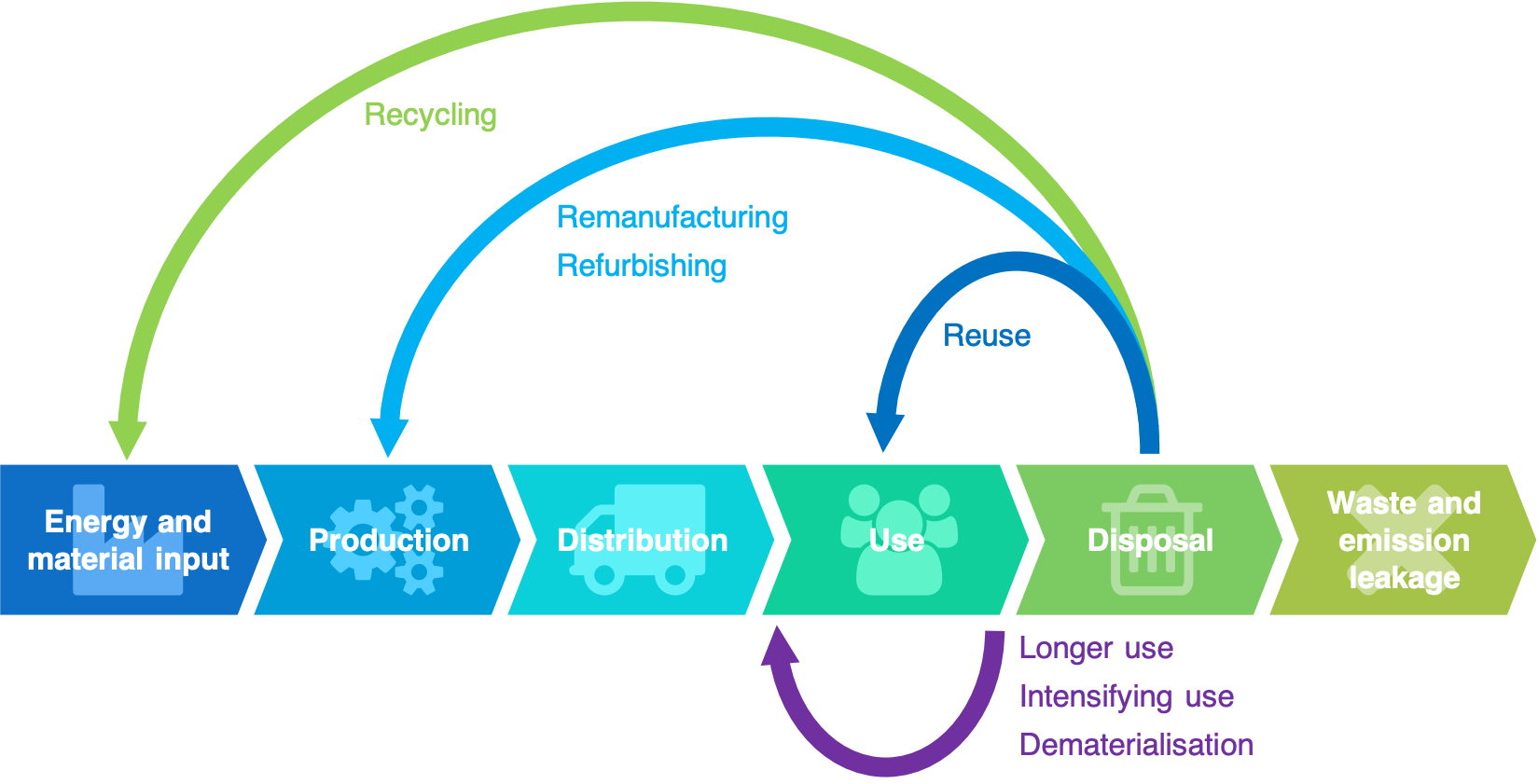
What is the Circular Economy?
The circular economy is an economic model focused on extending the life of materials and eliminating negative environmental impacts through design, production, and services. Unlike the traditional economy, which emphasizes the extraction of resources, production, consumption, and disposal, the circular economy emphasizes managing and regenerating resources within a closed-loop system to prevent waste.
The transition to a circular economy offers a significant opportunity for sustainable development. It helps achieve socio-economic and environmental goals while addressing climate change.
Principles
The circular economy operates on several fundamental principles that aim to rethink the design and lifecycle of products and systems. These principles include:
- Design for reuse: Products should be designed so that their biological and chemical components can be easily separated and reused in new cycles, eliminating waste.
- Resilience through diversity: Systems with diverse internal connections are more resilient and adaptable to external shocks. This applies to economic systems as well, where a diverse network of businesses and supply chains ensures greater flexibility.
- Use of renewable energy: The use of renewable energy sources is crucial to sustain circular processes that require additional energy for activities such as upcycling.
- Systems thinking: Understanding non-linear systems, particularly feedback loops, is essential for optimizing the interdependencies in the circular economy. These systems function at various levels, reinforcing the economy’s flexibility and sustainability.
- Biological foundation: Many consumer goods are increasingly based on biological materials, which can be used for multiple purposes before returning to natural cycles.
Global Perspective
According to the United Nations Development Program (UNDP), by 2030, the circular economy could generate $4.5 trillion and support 10 out of 17 UN Sustainable Development Goals (SDGs). The European Union (EU), China, Japan, the UK, France, Canada, the Netherlands, Switzerland, and Finland are all proponents of the circular economy.
Sweden
Sweden has a highly developed economy and aims to be free from fossil fuels by 2040. The circular economy, particularly low-carbon waste management based on biological foundations, is a key factor in achieving this goal. However, Sweden faces challenges in coordinating efforts between the government, businesses, and sectors.
China
In response to environmental challenges, China implemented its *Circular Economy Promotion Law* in 2009, which focuses on resource efficiency and environmental protection. China also offers tax incentives and subsidies to businesses transitioning to a circular economy.
Japan
Japan’s lack of space for waste and limited natural resources prompted an early shift toward a circular economy. Since 1991, Japan has implemented recycling laws that require companies to recycle their products. Japan’s circular economy aims for zero waste through product lifecycle assessment, waste minimization, and resource recycling.
The status in Vietnam
Current Situation and Opportunities
Vietnam has achieved economic growth by relying on resources and cheap labor, but it now faces serious challenges such as resource depletion, environmental pollution, and climate change. The country ranks fourth in the world for plastic waste, generating 1.83 million tons annually. The World Bank predicts that Vietnam will lose approximately 3.5% of its GDP by 2035 due to air pollution.
Several models exist in Vietnam, including scrap metal and paper recycling, as well as agricultural models like *garden-pond-barn* and *forest-garden-pond-barn* systems. Other notable examples include ecological industrial zones in Ninh Binh, Da Nang, and Can Tho.
Despite progress, there is much potential for expanding the circular economy in Vietnam. The country can learn from other nations and align with the global trend towards sustainable economic practices. High-tech applications and digital transformation present opportunities for further growth in this area.
Challenges
Vietnam faces several challenges in implementing a circular economy, including:
Lack of a legal framework: While policies exist for green and sustainable growth, no formal legal framework supports the development of a circular economy.
Low public and business awareness: The public and businesses in Vietnam have limited understanding of the circular economy. The concept of “waste as a valuable resource” has not yet gained widespread recognition.
High costs and technological demands: Implementing a circular economy requires significant investment in technology and energy-efficient equipment, which can affect profits.
Inconsistent recycling systems: Vietnam must ensure consistency across the recycling process. For instance, separating waste but mixing it together later nullifies the efforts of waste management.
Recommendations for Vietnam
To fully embrace a circular economy, Vietnam must create a clear plan with specific goals and ensure broad societal consensus. Establishing a legal framework is also critical, and the government must encourage public participation. Tax policies could promote the use of renewable resources and discourage the consumption of non-recyclable materials.
Businesses should be incentivized to adopt clean production methods and recycle more through tax breaks, financial support, and the introduction of financial mechanisms that hold them accountable for their products after use. The Ministry of Finance can play a key role by developing standards for recycled products and managing financial mechanisms to promote the circular economy.
Conclusion
The circular economy represents a shift away from the traditional linear model of production and consumption, focusing instead on sustainability and the regeneration of resources. As more countries implement policies, the potential for global economic growth, environmental protection, and climate change mitigation increases. Vietnam, like other nations, faces challenges but also has opportunities to capitalize on the circular economy for sustainable development. Through the right policies, public awareness campaigns, and business incentives, Vietnam can accelerate its transition to a circular economy and contribute to global sustainability efforts.
—


